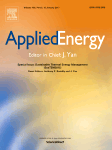Applied Energy
Fast-growing and short-rotation biomass is identified as glucan-rich feedstock to be used for bioenergy purposes. For the first time to our knowledge, fast growing biomass (Paulownia tomentosa) was evaluated for bioethanol production in a biorefinery scheme. For that, Paulownia wood was subjected to autohydrolysis pretreatment under severity (S0) conditions in the range of 3.31–5.16. The effect of this treatment on its fractionation was evaluated by means of hemicelluloses solubilization as hemicellulose-derived compounds in liquid phase and enzymatic hydrolysis of glucan (remained in the solid phase) into glucose. A xylose and xylooligosaccharides concentration of 17.5 g/L was obtained at S0 = 3.99 which corresponds to complete xylan solubilization. On the other hand, glucose yield of enzymatic hydrolysis increased up to reach 99% at S0 = 4.82. In addition, separate and simultaneous saccharification and fermentation assays (SHF and SSF) of autohydrolyzed Paulownia were compared for ethanol production. An increase of 47% in ethanol concentration was obtained by SHF in comparison with results achieved by SSF for Paulownia treated at S0 = 4.19. In SSF, Paulownia was successfully converted into ethanol (52.7 g/L which corresponded to 80% of ethanol yield) operating at 20% solid loadings and S0 = 4.72. Energy analysis of results obtained in this work showed that 83% of energy respect to raw material can be recovered considering the ethanol and the combustion of residual lignin. This work provides a feasible process for bioethanol production using fast growing specie which could enrich the feedstock needs for biofuels sector.

